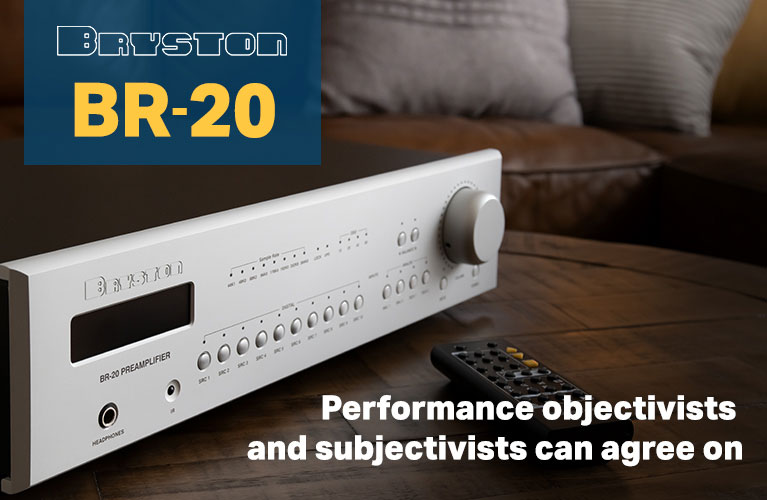Hegel Music Systems, of Norway, does things a little differently from many audio manufacturers. They make pre- and power amplifiers, standalone D/A converters, even a CD player, but they’re best known for their integrated amplifier-DACs, of which they currently have five models in production. Their SoundEngine technology uses feed-forward correction, a type of circuitry quite unlike the negative feedback used in most class-AB amplifiers. And since long before the practice was as common as it is today, every Hegel integrated has included an internal DAC.
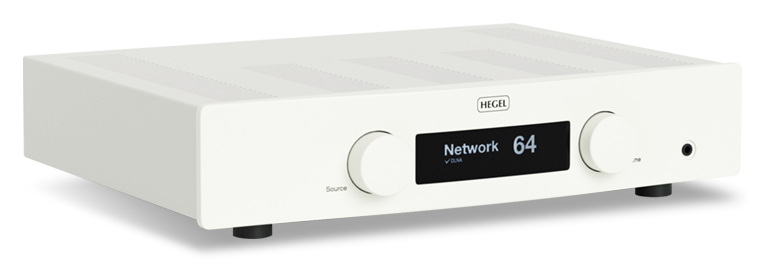
Hegel’s latest product, the H120, is the next model up from their least-expensive integrated-DAC, the H90 ($2000 USD). The H120 isn’t inexpensive at $3000, but Hegel has never been about chasing the bottom of the price range. Instead, they’ve consistently offered products of unique design that are priced for the high quality of sound they provide. Just ask our own Hans Wetzel, who, since 2012, when he reviewed the H300, has used only Hegel integrated-DACs as his reference amplifiers. My own experience with Hegel dates back to 2014, when I reviewed the entry-level H80; ever since, though I’ve never bought a Hegel, I’ve always admired their products.
Integrated design
The H120 looks like Hegel’s other integrated-DACs, the main difference being the larger cases of the more expensive, more powerful models. With their gently rounded edges and corners, large knobs, and slightly convex faceplates, I’ve always found Hegel’s integrated-DACs attractively minimalist and tastefully modern -- they’re studies in simplicity. Like the Röst before it, the H120 is available in a case finished in a chic matte white or their standard black. My listening room isn’t the epitome of home décor, but the understated H120 looked great in white, and stood out among the mundane black finishes of most of my components.
The H120 measures a svelte 16.93”W x 3.93”H x 12.20”D and weighs a surprisingly hefty 25 pounds. The faceplate’s large, easily read central display is surmounted by Hegel’s logo and flanked by two large knobs, Source and Volume; the action of both was smooth. There’s a headphone jack at far right, and that’s it for the front panel. The power button, hidden away at center front on the bottom plate, is easy to find and use.
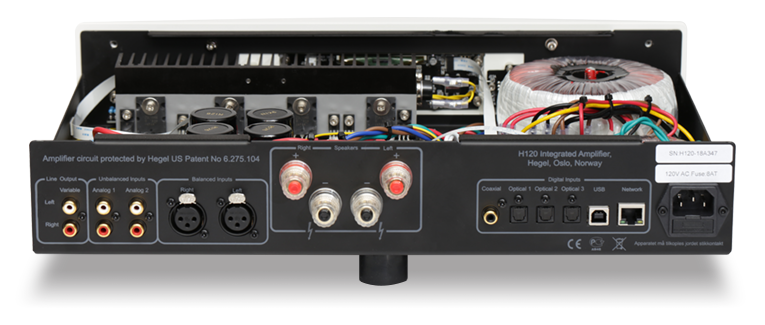
On the rear panel are two pairs of unbalanced (RCA) and a single pair of balanced (XLR) inputs, and a pair of preamp (RCA) outputs. Any of the analog inputs can be set to a fixed level to use as a home-theater bypass. The digital inputs comprise three optical S/PDIF (TosLink), one coaxial S/PDIF (RCA), one USB Type-B, and Ethernet. There’s also an IEC inlet for the removable power cord. The five-way binding posts are vertically staggered for ease of connection, but are relatively close to each other and the other connectors, especially the balanced inputs -- if you use heavy-duty speaker cables with spade connectors, things might get a bit tight.
While I like the clean, unpretentious look of Hegel components, I’ve also always been drawn to their clear, exciting sound. The H120 includes the latest version of their amplifier technology, SoundEngine2, and includes a modest but robust power output of 75Wpc into 8 ohms, a minimum-load recommendation of 2 ohms, and a damping factor of more than 2000. It has two power supplies and two toroidal transformers, one for the power-amp section, and another, smaller one for the preamp section. The feed-forward design of SoundEngine2 is clearly and succinctly explained by Bent Holter, Hegel’s founder and chief designer, in a SoundStage! Shorts video. Instead of applying a global negative-feedback signal at the beginning of the circuit, SoundEngine2 uses an “analog computer” to insert a correction signal into the circuit at each stage of amplification, before the signal is amplified by the next stage, to cancel out distortion.
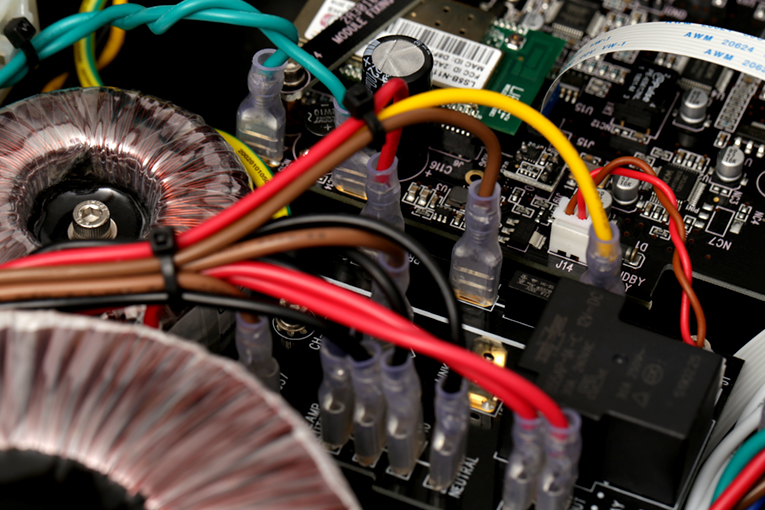
Hegel says that their USB input, which is adaptive rather than the more common asynchronous, is more like a soundcard or audio controller and should easily connect to any recent Mac, Windows, or Linux OS without the need for a driver to be installed. Once I’d figured out that the “TE7022 Audio w/SPDIF” device now visible to my Lenovo IdeaPad computer was actually the H120, I had no problem using the USB input. But even that was no challenge -- it was the only new device my computer displayed after I’d connected it to the Hegel, and it’s mentioned by name in the H120’s manual, though not prominently. Neither did foobar, Qobuz, or Roon have any trouble identifying and connecting to the H120 via my Windows PC -- and Hegel says that a future software update will make the H120 Roon Ready. The H120 also supports Apple AirPlay, Spotify, and UPnP streaming, and is Control4 ready.
According to Anders Ertzeid, Hegel’s VP of sales and marketing, the H120’s DAC section is identical to the H190’s -- in fact, this is the first time they’ve offered such a high-quality DAC at this price. However, they don’t claim that it’s as good as the reference-quality DAC sections found in their H390 ($6000) and H590 ($11,000) integrateds, which use AKM’s very best DAC chip. The H120 uses a less-advanced AKM chip, but Hegel says that its digital section nonetheless features very low jitter, and that its analog stage is of very high quality -- along with better power supplies, balanced circuitry, and higher-quality components than their H90.
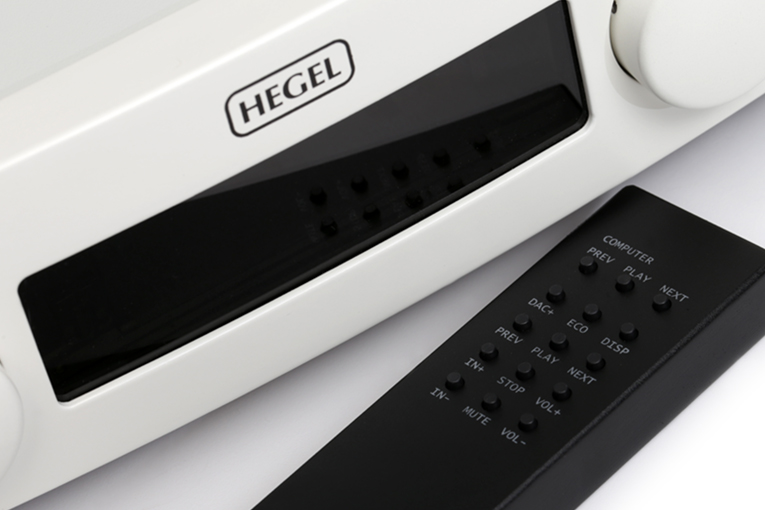
The RC8 remote control (provided) is a chunky metal box with a matte-black finish and small plastic buttons that have a positive feel. Although this remote seems solid and well made, its boxiness doesn’t quite match the H120’s sleek, modern aesthetic -- a small criticism. In addition to operating the H120, the remote’s play/pause and previous/next buttons controlled those functions in my playback softwares via USB; there was a slight delay with foobar2000, but with Qobuz and Roon, the remote’s response was nearly instantaneous.
Setup
As mentioned, the H120 didn’t require download and installation of a driver before being connected to my Windows laptop via USB -- my main method of playback from foobar2000, Qobuz, and Roon. My reference system included pairs of MartinLogan Masterpiece Classic ESL 9 hybrid electrostatic and PSB Alpha T20 speakers. I also evaluated the Hegel through its coaxial digital and balanced analog inputs using my Oppo UDP-205 4K Ultra HD universal BD player.
I had no Spotify account to use with the H120, but confirmed its compatibility with AirPlay and UPnP when I connected it to my home network to check for any firmware updates from Hegel. An update was indeed available -- downloading and installing it took only a minute or two. The H120 had no problem playing music files stored on my Android phone via Qobuz with Bubble UPnP, or with iTunes on an iPhone S via AirPlay. However, once I’d confirmed that UPnP and AirPlay were working correctly and had installed the latest version of the firmware, I unhooked the H120 from my network and listened to it primarily through its USB input.
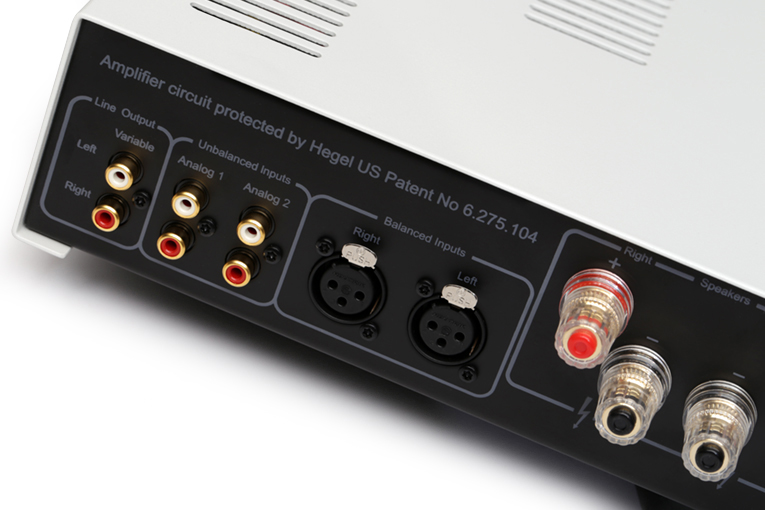
Being an integrated-DAC, the H120 required little wiring. I used Clarus Aqua Mk.II speaker cables, interconnects, and power cords, and an AudioQuest Carbon USB link. As usual, wall AC was sent through power conditioners from ZeroSurge and Blue Circle Audio.
Ladies and gentlemen, start your SoundEngines
The H120 may be specified as producing a relatively modest output, and may not have the latest boutique DAC chip, but while Hegel’s designs are rooted in advanced engineering, the company has always been more about sound quality than specs. Its output of just 75Wpc into 8 ohms didn’t keep the H120 from driving my MartinLogan ESL 9s to levels that many similarly specced integrated amplifiers would have difficulty achieving. Listening to “To Be a Lover,” from Billy Idol’s Whiplash Smile (24-bit/96kHz FLAC, Capitol/Qobuz), I heard plenty of drive, even if the H120 couldn’t squeeze the bottommost lows from the two 8” woofer cones of each of my MLs, or the fastest, most precise midrange from their electrostatic panels. But the electric bass was still lusciously plump and rich, and Steve Stevens’s slashing electric-guitar riffs cut through the throbbing bass line with surgical precision.
While electric guitars through the H120 had the clean, clear sound I associate with Hegel amps, they didn’t seem quite as up-front as I remembered from reviewing the H80, or from any of the other, earlier Hegels I’ve listened to. For example, Alex Lifeson’s guitar in “Red Barchetta,” from Rush’s Moving Pictures (24/96 FLAC, Mercury/HDtracks), had remarkable clarity, as did Geddy Lee’s voice -- but the sound also had an overall smoothness and neutrality from top to bottom. The sound of Lee’s bass was taut, but still weighty enough to provide sufficient punch to compete with the late Neil Peart’s skillful drumming -- the combo provided a great sense of timing. The voices in Rush’s signature song, “Tom Sawyer,” were pushed slightly farther forward on the stage, making Lee stand out from this lush mix, but still not as prominently as I recall him sounding through the H80. The synth effects, including the cool sweep at the beginning of the track, were spread wide across the soundstage with a satisfying richness that was a ton of fun to hear.
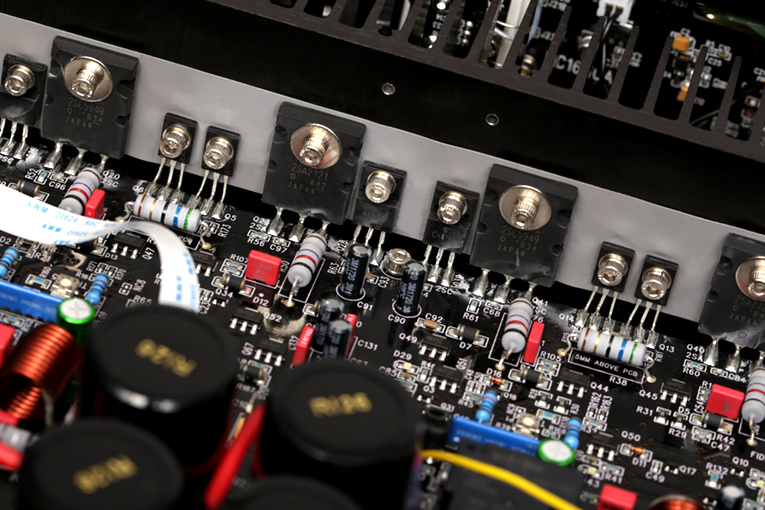
The H120 was able to cast a huge image of Oscar Peterson’s instrument in “Honeysuckle Rose,” from his solo-piano album Tracks: Remastered Anniversary Edition (24/88.2 FLAC, MPS/Qobuz), and had my speakers jammin’ with great pace as the notes flowed freely, without restraint. The same was true of the H120’s reproduction of his cover of Al Dubin and Harry Warren’s “Lulu’s Back in Town,” from another solo-piano album, My Favorite Instrument: Exclusively for My Friends, Vol.4 (24/88.2 FLAC, MPS/Qobuz).
But while the H120 could capture the essence of Oscar Peterson’s masterful performances, it really shone with more recent jazz recordings. Nat Cole’s “Straighten Up and Fly Right,” as performed by Diana Krall on her very first album, Stepping Out (Remastered) (24/96 FLAC, Justin Time/Qobuz), provided a great sense of her trio’s intimate performance, with a perfect balance of instruments and voice. An instrumental, “Between the Devil and the Deep Blue Sea,” provided an opportunity for the H120 to present an exceptional reproduction of Jeff Hamilton’s drums and his sublimely deft brushwork on snare, at dead center. The sounds of his various brushstrokes moving across the skin were subtly differentiated. His toms and cymbals were positioned across the soundstage at various heights, as the recording zoomed in in exaggerated manner, providing a striking if unnaturally large image of Hamilton’s percussion battery. After his solo, Krall enters on piano -- its sound, too, spread wide between the speakers, with John Clayton’s double bass ever so slightly left of center. Although this track is not recorded at a particularly high level, it was filled with tons of detail, and swung through the H120.
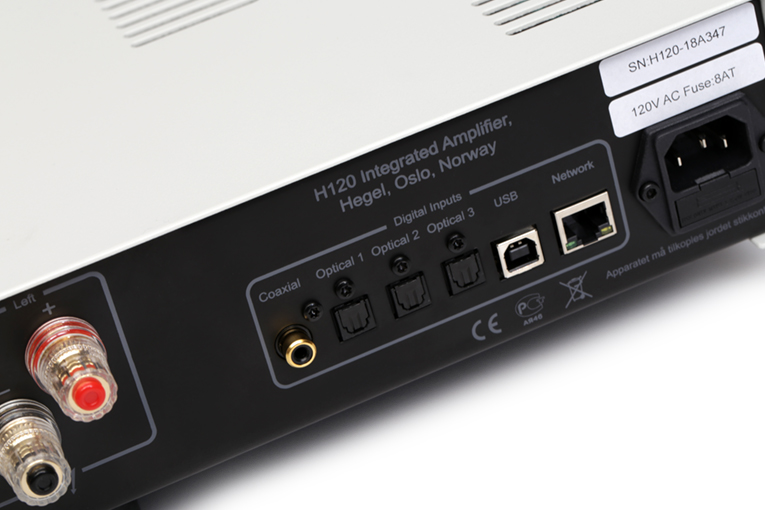
While the H120 couldn’t quite drive my ML ESL 9s with the authority I’m used to from my 1000W Anthem M1 monoblocks, it did a fantastic job with the much smaller but overachieving PSB Alpha T20s. Jann Arden’s voice in “Good Mother,” from her Living Under June (16/44.1 FLAC, Universal), came through crystal clear, precisely placed between and slightly behind the PSBs. “Could I Be Your Girl” sounded even clearer, the acoustic guitar being especially clean and layered behind Arden and the backing singers. Granted, the Alpha T20s aren’t exactly difficult to drive -- still, no matter what I played, the H120 did a significantly better job of controlling the PSBs than does my budget reference combo of Oppo BDP-105 universal BD player ($1199, discontinued) used as a DAC-preamp and an Axiom ADA-1000 multichannel amplifier ($1530, five-channel version), even with the Axiom biamping the T20s.
I also used the H120’s balanced analog inputs with the Oppo UDP-205 universal BD player. That sounded different, but not demonstrably better or worse than the H120’s internal DAC. With “Desert Rose,” from Sting’s My Songs (16/44.1 FLAC, A&M), the Oppo’s analog outputs had a livelier sound that highlighted Sting’s voice, placing it in greater relief against the backing voices and instruments, though at the expense of some imaging depth. And while the sound was clearer with the analog signal coming from the Oppo, the reduced spatial differentiation between the voices resulted in Cheb Mami’s voice not being as conspicuously in front of Sting’s as it was through the H120’s DAC. I always enjoyed listening to the H120, whether through its digital or its analog inputs; I’d think twice before spending additional money on an external DAC.
Although I was very satisfied with the performance of the H120’s DAC, its USB input is limited to a maximum resolution of 24/96 and won’t accept the sampling rate of 88.2kHz. However, it does accept 48kHz and, obviously, the very common 44.1kHz. The S/PDIF coaxial RCA and TosLink inputs accepted all common sampling rates, from 44.1 up to 192kHz, including the relatively rare 176.4kHz.
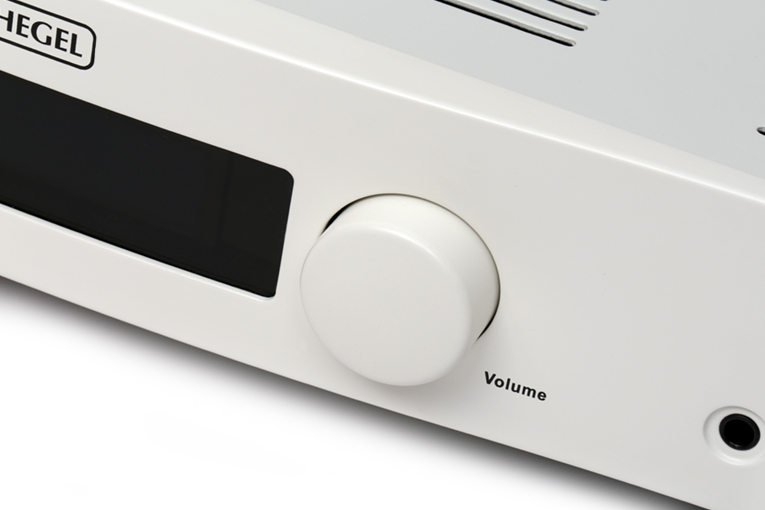
Like many of today’s preamps and integrated amps, the H120 has a headphone output. It easily drove my pair of Sennheiser HD 580 headphones with a pleasantly rich sound, but without the authority of the Oppo UDP-205’s headphone output. Through the Oppo, the bass guitar in “Fragile,” from Sting’s My Songs, had more body and was more impactful, almost startlingly so. And while, through speakers, the Hegel’s internal DAC was better able to extract the spatial cues excited by Cheb Mami’s voice in “Desert Rose,” than through the Oppo’s analog outputs, the opposite was true of the headphone amps: through the Sennheisers, Mami’s voice was better differentiated by the Oppo.
Hegel’s got those looking for a higher-performing integrated-DAC covered with their H390 ($6000) or their statement H590 ($11,000). On a recent visit to Doug Schneider’s home I heard an H390 driving a pair of Vivid Audio Giya G2 Series 2 speakers and was tremendously impressed with it. The H120 didn’t reach the heights of sound quality enjoyed by the more-expensive integrated-DAC, but it offers great value in a compact and economical package at just half the H390’s price.
Audio idealism
At $3000, Hegel Music Systems’ H120 provides high qualities of amplification and digital-to-analog conversion, in addition to basic streaming capabilities, in a solidly built and well-executed design. While Hegel’s rock-star integrated-DAC, the H590, may deserve the many accolades it’s received, their middle child, the H120, should not be overlooked by anyone looking for a moderately priced, high-performing integrated-DAC. It only further solidifies my perception of Hegel as a premier manufacturer of integrated amplifier-DACs.
. . . Roger Kanno
rogerk@soundstagenetwork.com
Associated Equipment
- Speakers -- MartinLogan Masterpiece Classic ESL 9, PSB Alpha T20
- Preamplifier -- Anthem STR
- Amplifiers -- Anthem M1 (monos), Axiom Audio ADA-1000 (five-channel)
- Integrated Amplifier-DAC -- Lyngdorf Audio TDAI-3400
- Sources -- Lenovo IdeaPad computer running Windows 10, foobar2000, Qobuz, Roon; AudioQuest JitterBug, Oppo Digital UDP-205 4K Ultra HD and BDP-105 universal BD players
- USB link -- AudioQuest Carbon
- Speaker cables -- Analysis Plus Silver Apex, Clarus Aqua Mk.II
- Interconnects -- Analysis Plus Silver Apex, Clarus Aqua Mk.II
- Power cords -- Clarus Aqua, Essential Sound Products MusicCord-Pro ES
- Power conditioners -- Blue Circle Audio PLC Thingee FX-2 with X0e low-frequency filter module, Zero Surge 1MOD15WI
Hegel Music Systems H120 Integrated Amplifier-DAC
Price: $3000 USD.
Warranty: Two years parts and labor.
Hegel Music Systems AS
PO Box 2, Torshov
NO-0412 Oslo
Norway
Phone: +47 22-60-56-60
Fax: +47 22-69-91-56
E-mail: info@hegel.com
Website: www.hegel.com






















